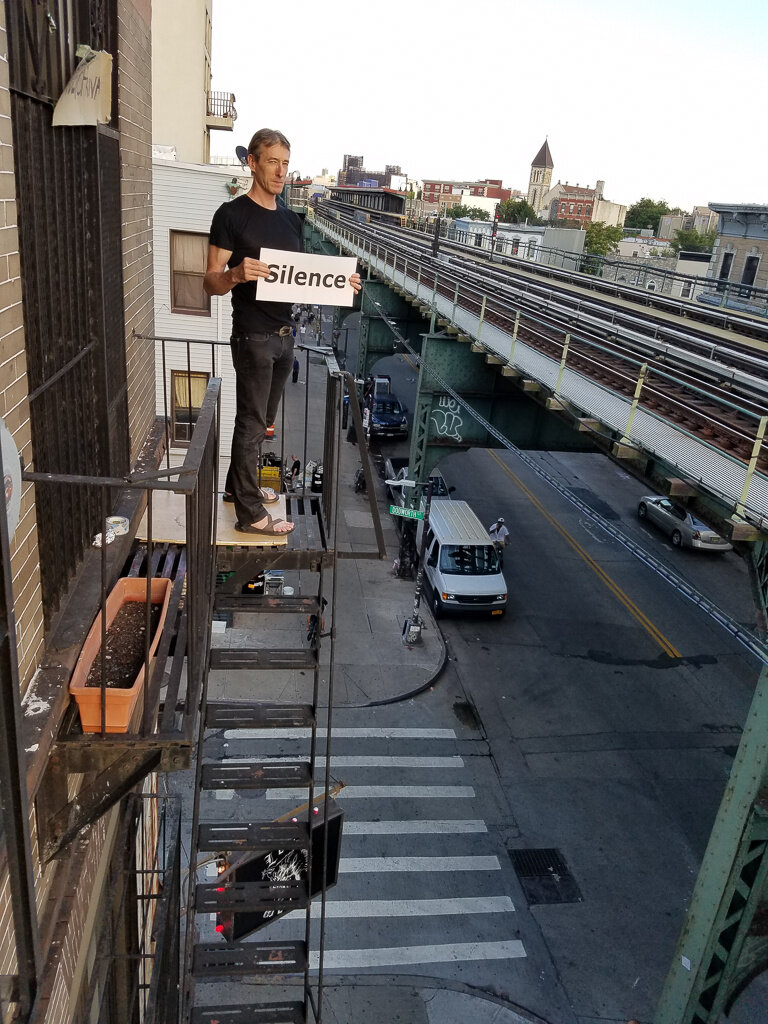I organized this site specific series of renegade performances in response to the lack of privacy I experience living in Bushwick, Brooklyn in summer 2016. There was nowhere I go in this city that I did not hear, see, smell, feel or taste human presence. The space where I lived and worked was equally porous. During morning and evening commuting hours the J train repeatedly stopped for several minutes at a time feet away from our bathroom window. Coming from the more sparsely populated Midwest, I was shocked that my housemates have become comfortable taking a shit and showering with only a thin tulle curtain shielding neighbors’ and commuters’ views of bathroom activities. After dark when lights are on inside the bathroom our activities are even more visible to viewers outside. During the first week of my stay I put up a piece of cloth over the bottom part of the window to create more privacy for myself. Later I realized that people on higher floors of the building opposite ours could still see in through the top part of the window, but at that point I had adapted to the lack of privacy and didn’t really care. At the beginning of the performance series I rode the train to document the artists’ actions and almost missed the performances. Our performances were fleeting moments, invisible to most riders of the train and most passengers on the subway. There are so many other people, windows and digital screens to look at, our window and fire escape are insignificant blips in the midst of the constant stream of images, bodies, sounds, smells and tastes in this city. And then, our actions ARE significant. The dialogues that happened between performers and people on the street, the images posted on Instagram and Facebook by strangers on the subway elucidate interaction, meaning-making, communication and disruption in the everyday humdrum of a commute. As the series progressed I also became aware that the voyeurism was working in multiple directions. While we created actions on the fire escape we looked into the living rooms and kitchens of people living across the tracks. We watched people walking on the sidewalk below who were unaware they were they were being watched. In addition, we took photos and videos of these unsuspecting strangers and posted them on the internet.
Perhaps living in New York is living in public all the time. Maybe there is no division between public and private. Privacy is a mental state created by putting on headphones, signalling a desire to disengage sonically with our surroundings. There are bathrooms in this city with no windows to the subway, but we often take our cell phones into those private spaces so we are still connected to a world beyond our visual surroundings. We humans crave constant connection with each other, through all our senses. The word public implies a collective ownership, private implies restricted and only available to some. Social practice art, socialism, socially engaged art, community engaged practices all seek to break down power structures, to bring more equality to the world, to heal divisions created between us as a result of current and past violence. This performance series problematizes the boundaries of what is public and what is private. We expose actions, words, gestures, emotions, bodies that are usually kept secret or shared privately only with the people closest to us. We make visible women’s sexuality and menstruation. We speak to the seduction of capitalism that creates waste, artificiality in the absence of deeper human connection. We shout the frustrations we usually refrain from voicing. Our actions disrupt the smoothed over, tamed, cleaned up, mind-numbing, placating, gentle, G-rated, Fox News, sitcom safe imagery that upholds the patriarchal, post-colonial power structure in which we live. Our actions are an invitation to change, to get off the train, to speak to a stranger, to take a different route, to imagine a more just world, to create a peace, to demand freedom, to stop, to breathe, to listen, to give, to live fully, creatively in the way only you can.













